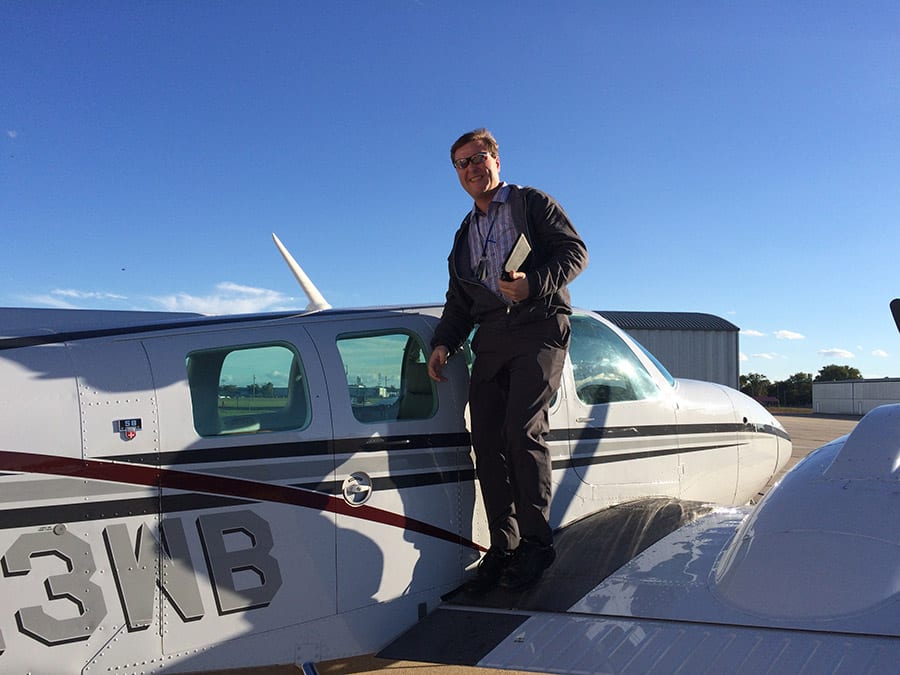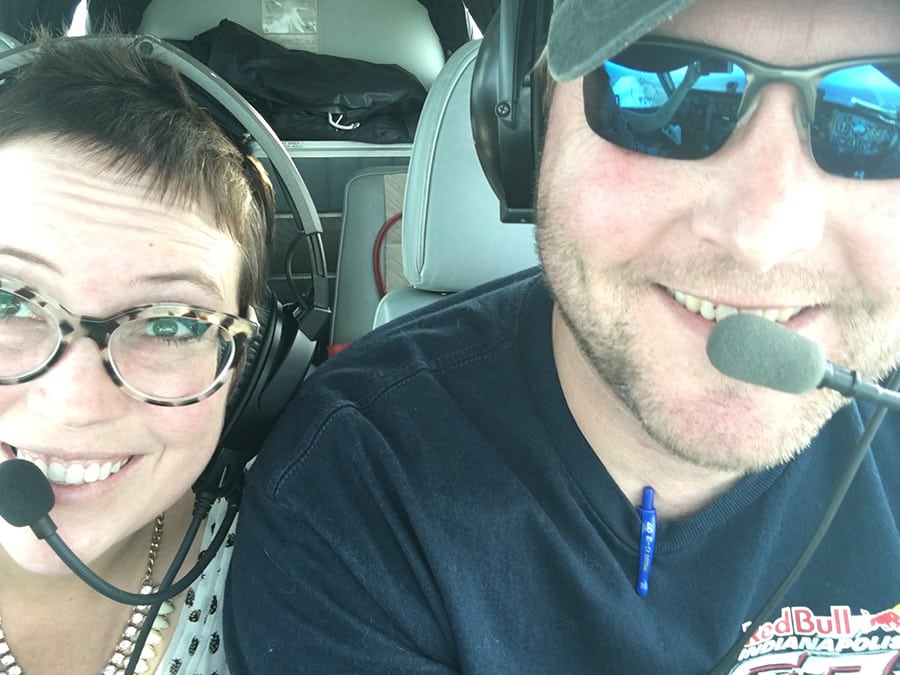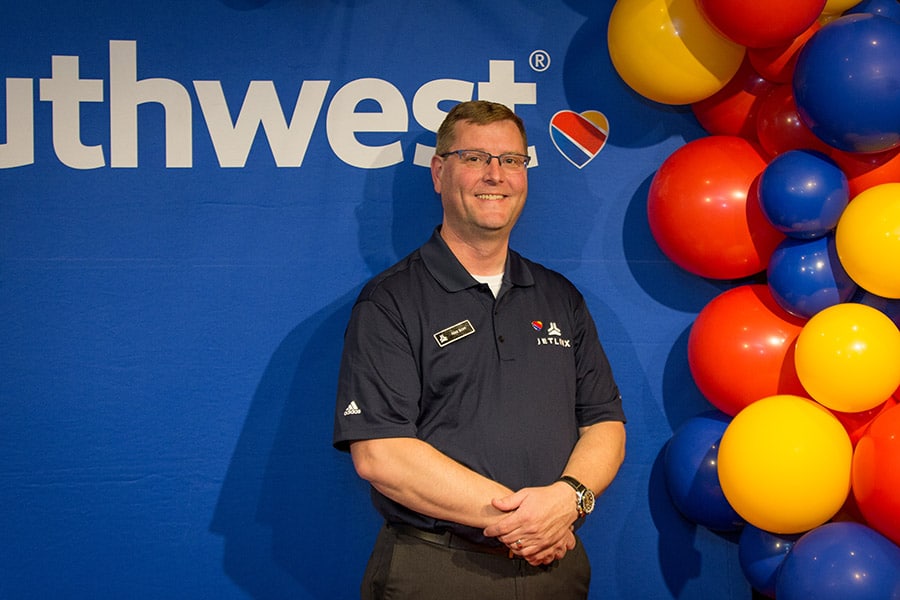Interview with an Aviator: Michael Kopp
In this installment of Interview with an Aviator, we introduce a member of the Jet Linx team celebrating his 20th year with the company in May 2021 (making him one of the most veteran team members in the country) – pilot and Director of Operations Michael Kopp.
Kopp’s story, from growing up on an acreage in Wisconsin to flight instruction then flying a B-58 Baron for a hog farm builder in the Midwest, revolves around the constant desire to improve and evolve as a professional in the ever-changing field of aviation. Kopp has 25 years of experience as a pilot in On-demand Charter (135) Operations. He joined Jet Linx in 2001, first serving as a pilot in the original Jet Linx Mitsubishi MU-300 Diamond fleet, and later as the Chief Pilot, where he played a crucial role in obtaining the Company’s initial Part 135 certificate. He assumed the role of Director of Operations in 2014.
As the Director of Operations, Kopp oversees day-to-day operations, General Operations Manuals, Operations Specifications and works closely with operational teams including Chief Pilots, check pilots and the training department. He also serves as the liaison between the company and the FAA for regulatory matters.
ARE/WERE ANY OF YOUR RELATIVES INVOLVED IN AVIATION?
My father began to take flying lessons on the GI bill after his return from Vietnam. He initially joined the Army to become a mechanic but was assigned as an Air Traffic Controller. Back then, flight lessons were as cheap as $4.00 per hour, so I think that partially convinced him to take lessons. My father took everything he did very seriously, including flying, so I think some of that interest rubbed off on me.
WHEN DID YOUR INTEREST IN AVIATION BEGIN AND WHY?
My dad bought his first airplane, a Piper Cherokee Challenger, before finishing his private pilot license, and my first ride in an airplane was with the salesman who delivered it. Throughout the years, my dad slowly upgraded airplanes and his qualifications. He purchased a Piper Lance and completed his instrument rating, then upgraded that aircraft to a Piper Saratoga. Winter flying in Wisconsin posed plenty of challenges with icing, so he eventually earned his multi-engine rating and purchased a Piper Seneca III. Throughout all of those years, we took family trips in the airplane and once I was old enough to drive a car, I got one-way flights to quite a few auto auctions where I then had to drive the cars back home. My dad’s interest in aviation afforded me the opportunity to take flying lessons in high school, and at the time I had no idea I would make a career of it – I just figured I’d end up in the car business.
For my private pilot check ride (just after my high school graduation), I rented a Cessna 152 and flew from Eau Claire to Marshfield Municipal Airport on a solo cross country to meet with the designated pilot examiner. The examiner turned out to be the salesman who gave me my first ride in an airplane!

CAN YOU DESCRIBE YOUR CAREER PATH BEFORE COMING TO JET LINX?
Being a pilot seemed like a good way to earn a living, so I packed up my brown Dodge Aspen and drove to Oklahoma. I attended Spartan School of Aeronautics in Tulsa, Oklahoma. There I completed commercial, instrument, multi CFI/CFII and MEI ratings. Upon completion of my initial Flight Instructor rating, I was hired by Spartan as an instructor and continued my education through a partnership that Spartan had formed with Phillips University. Through that program I earned a Bachelor of Business Administration. I was a full-time flight and ground instructor for roughly three years.
At the time in the mid-90s, entry level pilot jobs often came with a price tag to pay for your own training. Instead of going that route, I stuck with flight instructing, training Commercial Instrument or Certified Flight Instructor (CFI) candidates. I trained more than 50 individuals for their commercial and instrument ratings and over a dozen through their initial Flight Instructor rating.
My next job was in Nebraska. A former student of mine was working for a construction company that had two airplanes and a single-pilot 135 certificate. He was moving back east and recommended I apply for the job. I rented a Cessna 172 and flew to Columbus, Nebraska, to check out the town. As it turns out, it was the only day I would ever experience in Nebraska that didn’t have winds in excess of 30 MPH. So, the nice weather and the cool high-performance airplanes (a B-58 Baron and a Bonanza) led me to think Nebraska could be a nice place to work. My job duties included flying all over the Midwest, mostly to uncontrolled fields with non-precision approaches. I learned what a cruise clearance means, and I don’t think I landed at an airport with a control tower more than once a month (they do not build hog barns in urban environments often!).
I learned a lot about flying in those single pilot days because I was responsible for other duties in the FBO, such as following Part 135 charter rules and operations management. By flying salespeople and working with maintenance teams, I formed a good idea of how a business runs – and far too much knowledge on how to build a hog barn. After some time, I ended up moving to Omaha to work for Elliott Aviation. The opportunity to move into different equipment was the primary reason for the move and Elliott Aviation had a great reputation in the community.
WHAT AIRCRAFT TYPES HAVE YOU FLOWN?
I really enjoy all aircraft because they are all so different. The Bonanza and the Baron are sporty, King Airs do everything you need and don’t take you too far from home. If I had to pick a favorite aircraft that I have flown for Jet Linx, I would say the Hawker.
HOW MANY FLIGHT HOURS DO YOU HAVE?
I’ve logged nearly 9,000 hours and I’m typed and current in Beechjets and Hawkers. This includes the BE-400A, BE-400XP, and the Hawker 800, 850 and 900XP. I am also authorized as a check pilot in those aircraft types.
WHAT ARE YOUR FAVORITE FLIGHT ROUTES OR DESTINATIONS?
For me, it’s not the destination, it’s the way you get there. There is a lot to be said for a solo cross-country flight to a small town for a hamburger. But there’s also something to be said about flying into Teterboro Airport on a day with lower visibility, where crew teamwork gets you lined up perfectly on the final approach – all having never seen the ground 1,000 miles from where you started. Both have their pluses, but the trip home after time away from family is usually the favorite flight route.

How has your career progressed at Jet Linx?
I was initially hired in 2001 as a Captain on the Mitsubishi Diamonds and Beechjets. Back in those days, we actually operated on the certificate of another national operator – we did not manage our own. However, we were sparking interest in the community with our fractional and aircraft management approach, and it wasn’t long before we were exploring the idea of a Jet Linx independent certificate. Jet Linx had all the required personnel to run its own certificate: a local Chief Pilot and Director of Maintenance, along with flight coordinators and accounting staff.
We then set off to obtain an operating certificate in mid-to-late 2002. At that time, Maynard Smith, the Chief Pilot, took the role of Director of Operations, and Tony Boatwright became the Director of Maintenance for the certificate. I became the Chief Pilot, which we currently call the System Chief Pilot. The certification process included development of operations manuals, maintenance manuals, MELs and training programs. Maynard, Tony and I all played a role in the development of these initial requirements.
Upon completion of the manuals and the applications process, we were required to do proving runs. Proving runs are essentially flights with the FAA on board to demonstrate our ability to operate safely and in compliance with the manuals and procedures we had developed. In March of 2003, we completed the certification process and were issued the initial certificate: JX6A197K. You may note today that the certificate number is 9JLA375M. This changed because of the renaming of Jet Linx Aviation Corporation to Jet Linx Aviation, LLC in March of 2009 (fun fact
WHAT IS THE DIRECTOR OF OPERATIONS RESPONSIBLE FOR?
I’m the responsible party for certificate management at Jet Linx, so I work with the FAA. There are many levels to the role, from general operations manuals and training programs to operations specifications and addition and removal of aircraft from certificate. There’s also the general DOT economic authority and ensuring that we comply with all rules and regulations regarding the management of our foreign operating certificates to fly into the Bahamas and Mexico and so forth. I’m also responsible for the Drug and Alcohol Program. To put it very officially, the Director of Operations exercises control of all flight operations, directs the execution of Jet Linx policies and procedures, and ensures all activities of the operations department comply with Jet Linx standards.
AS SOMEONE WITH SUCH A UNIQUE PERSPECTIVE OF THE COMPANY, WHAT HAVE BEEN YOUR FAVORITE MOMENTS IN JET LINX HISTORY?
My favorite moments are celebrating the wins with fellow team members; when we’re all out of the office at a summer picnic or holiday party, and everyone is proud to be part of such a fine group of people. I also enjoy the leadership summits and the collaboration on setting goals and identifying opportunities for improvement. The concerted effort of an entire team of leaders to achieve those goals has always been inspirational to me. Seeing the evolution of and promotion of individuals within the company also makes me quite proud. Watching people grow from flight coordinator to Senior Vice President, from charter sales to Director of Fleet Management, and from newly hired Pilot as a Second-in-Command to a Pilot-in-Command on a Heavy Jet. The constant evolution of the company also makes me proud; we don’t settle for status quo and all of the leadership is committed to continuous improvement. The ability to scale while remaining compliant and safe are challenging and rewarding feats.
WHAT IS YOUR FAVORITE ASPECT ABOUT JET LINX CULTURE?
I enjoy the culture of continuous learning and dedication to growth. I like watching people strive to improve at all times, because in this industry you have to commit to doing that. You always have to learn more, accomplish more and grow more. There are new challenges and hurdles we face every day, and you have to be open to learning and changing in order to raise the standards necessary to improve. Evolution is part of the game and that’s why Jet Linx has been so successful; everyone here is part of that culture that’s committed to learning, growing and improving.
For example, when Tony Boatwright (Jet Linx Director of Quality) and I completed the work to put Jet Linx on its own certificate, we were relieved that all the hard work had been done – but after sitting back for a moment we realized that was just the beginning. We had no idea the amount of growth we’d experience in the next 20 years and the mountain of work required for us to get to the point where we are today. The job is never quite done, and that’s what makes me enjoy coming to work every single day.

DO YOU HAVE A FAVORITE JET LINX FLIGHT STORY?
One of my personal favorites was when former Jet Linx pilot Tony Yonkers and I were in Houston in the fall of 2010. Tony was also an Omaha pilot and at the time, he was in between dogs and not quite looking to get another one. We had an overnight trip to Houston for one of our regular clients. The trip down was uneventful; we arrived in the late afternoon and checked into a hotel across the street from the airport. Early the next morning we were having coffee, and we noticed a dog nosing around the hotel parking lot. We watched him roam about, and he turned and trotted back into the neighborhood behind the hotel. Thinking the dog was just making his rounds, we went about preparing for the day’s flight.
That afternoon, Tony and I arrived at Houston’s Hobby Airport to ready the plane for the return trip. As we were performing pre-flight checks, we saw an airport police truck racing down the taxiway, lights flashing, heading towards us. There was a guy in the bed of the truck with a loop, and another guy running alongside chasing this little wiener dog, who was running straight toward us (and right into Tony’s arms). Tony volunteered to take the dog home, but not before doing everything he could to try to find the dog’s original owner. He left notes for the Houston Humane Society, posted on the internet, but never heard anything back. We flew back to Omaha with the dog and midway through the flight we found our client feeding the dog a portion of his catering.
To this day we have absolutely no idea how that dog made it into the airport from the hotel. He had to cross busy streets, get through fencing, and more. It was something out of a movie, like a real-life rags to riches story with Hobby (named for the airport) the wiener dog – flying a private jet to his new life in Omaha.
WHAT ARE YOUR HOBBIES OUTSIDE OF AVIATION?
I don’t have an awful lot of time outside my job, but I do enjoy riding my motorcycles. I have three motorcycles that I enjoy riding and tinkering around with. I also know my way around the kitchen pretty well – I enjoy grilling and smoking when I have the chance.
DID YOU HAVE A MENTOR TO LEAD YOU ALONG THE WAY?
Clearly my dad, who while not a professional pilot, still set the tone for professionalism and attention to detail. His work ethic and discipline to do things right and finish a job are what I think have given me the mindset that the details do matter. Aside from that, the motivation to continue in aviation has always been the people and the common interest. You don’t often see pilots sitting quietly – we all have stories and want to hear yours too.
WHAT ADVICE WOULD YOU GIVE TO A YOUNGER VERSION OF YOURSELF, OR TO AN ASPIRING AVIATOR?
Just stay in the game. Even when there are financial hurdles, challenges or setbacks, stay engaged and continue
to push for the next goal. Never stop learning and never think the job is done. If you become complacent and think you have it all figured out, you are in a position to fall behind. For over 20 years, I have seen firsthand what a culture of continuous development, curiosity and drive can accomplish – and I look forward to seeing where the future takes us.
Related Stories
Celebrating the Women of Jet Linx
In celebration of Women’s History Month, Jet Linx proudly presents the stories of some the women in our leadership and those excelling in the cockpit.
READ MORE
Celebrating 25 Years: The Inception
From inception to the present – Jet Linx was built to be your partner in private aviation.
READ MORE
Interview with an Aviator: Victor Alvarez
In the latest installment of Interview with an Aviator, we sat down with Victor Alvarez, Jet Linx Boca Raton Pilot.
READ MORE
Related Stories
Celebrating the Women of Jet Linx
In celebration of Women’s History Month, Jet Linx proudly presents the stories of some the women in our leadership and those excelling in the cockpit.
READ MORE
Celebrating 25 Years: The Inception
From inception to the present – Jet Linx was built to be your partner in private aviation.
READ MORE
Interview with an Aviator: Victor Alvarez
In the latest installment of Interview with an Aviator, we sat down with Victor Alvarez, Jet Linx Boca Raton Pilot.
READ MORE



Contact Us